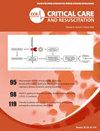Rinaldo’s role in the medical emergency team and rapid response systems
IF 1.7
4区 医学
Q3 CRITICAL CARE MEDICINE
引用次数: 0
Abstract
In the 1990s, there was emerging evidence that patients admitted to hospitals frequently suffered in-hospital cardiac arrest, unplanned admission to the intensive care unit (ICU), and potentially preventable in-hospital death. These events were often preceded by objective signs of instability and suboptimal recognition and response by hospital ward staff. Rinaldo Bellomo collaborated with key Australian and international leaders to develop a novel and paradigm-shifting model of care referred to as the medical emergency team (MET). This team is comprised of senior staff members who are experts in the assessment and management of acutely deteriorating patients.
In Australia and New Zealand, staff members from the ICU are frequently the team leaders for the MET. The team is called when a patient develops objective signs of clinical deterioration, prior to the onset of cardiac arrest. Rinaldo led, mentored, and supervised a systematic and structured research program that evaluated the nature and effectiveness of the MET at Austin Health and throughout Australia. This commenced with single-centre before-and-after studies and progressed to the first Australian ICU cluster-randomised controlled trial. His unique skillset was pivotal in the emergence and promulgation of this model of care worldwide resulting in countless lives saved from preventable morbidity and mortality.
雷纳多在医疗急救队和快速反应系统中的作用
在20世纪90年代,越来越多的证据表明,入院的患者经常出现院内心脏骤停,意外入住重症监护病房(ICU),以及可能可预防的院内死亡。这些事件通常发生在客观的不稳定迹象和医院病房工作人员的次优识别和反应之前。里纳尔多·贝洛莫与澳大利亚和国际主要领导人合作,开发了一种称为医疗急救小组的新型和范式转变的护理模式。该小组由高级工作人员组成,他们是评估和管理急性恶化患者的专家。在澳大利亚和新西兰,ICU的工作人员经常是MET的团队领导。当患者在心脏骤停发作前出现临床恶化的客观迹象时,该小组就会被叫来。Rinaldo领导、指导和监督了一个系统的、结构化的研究项目,该项目评估了奥斯汀健康中心和整个澳大利亚MET的性质和有效性。这项研究从单中心前后对照研究开始,并进展到澳大利亚首个ICU集群随机对照试验。他的独特技能在这种护理模式的出现和在世界范围内的传播中发挥了关键作用,从而使无数生命免于可预防的发病率和死亡率。
本文章由计算机程序翻译,如有差异,请以英文原文为准。
求助全文
约1分钟内获得全文
求助全文
来源期刊

Critical Care and Resuscitation
CRITICAL CARE MEDICINE-
CiteScore
7.70
自引率
3.40%
发文量
44
审稿时长
>12 weeks
期刊介绍:
ritical Care and Resuscitation (CC&R) is the official scientific journal of the College of Intensive Care Medicine (CICM). The Journal is a quarterly publication (ISSN 1441-2772) with original articles of scientific and clinical interest in the specialities of Critical Care, Intensive Care, Anaesthesia, Emergency Medicine and related disciplines.
The Journal is received by all Fellows and trainees, along with an increasing number of subscribers from around the world.
The CC&R Journal currently has an impact factor of 3.3, placing it in 8th position in world critical care journals and in first position in the world outside the USA and Europe.
 求助内容:
求助内容: 应助结果提醒方式:
应助结果提醒方式:


